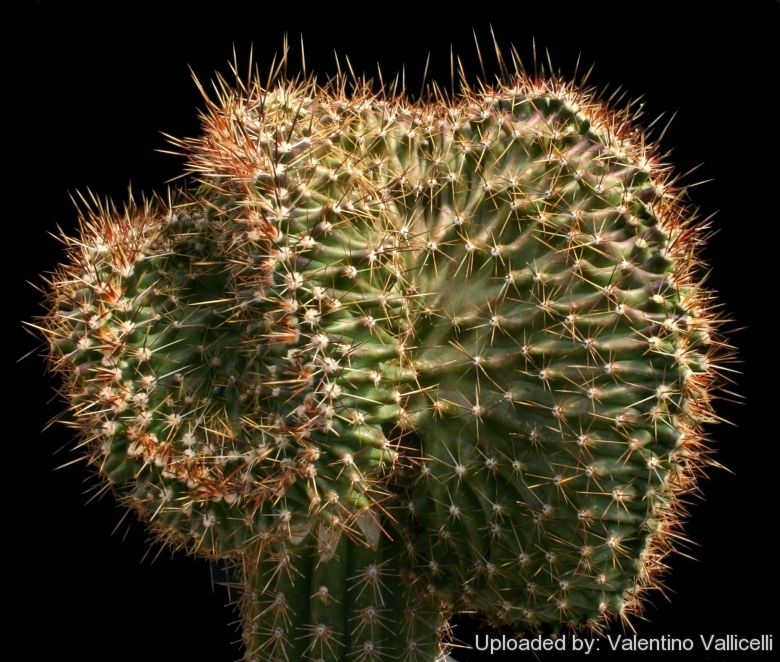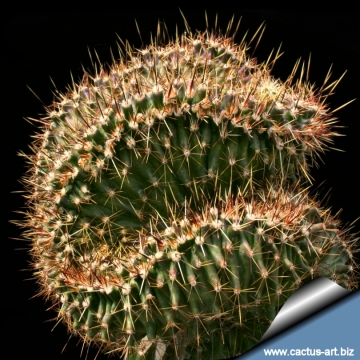Accepted Scientific Name: Echinocereus papillosus Linke ex Rümpler
Handb. Cacteenk. (ed. 2 - Rümpler) ed. 2, 783. 1885 Rümpler

Echinocereus papillosus f. cristatus Photo by: Valentino Vallicelli
Origin and Habitat: Garden origin (Nursery produced cultivar)
Synonyms:
See all synonyms of Echinocereus papillosus
back
Accepted name in llifle Database:Echinocereus papillosus Linke ex RümplerHandb. Cacteenk. (ed. 2 - Rümpler) ed. 2, 783. 1885Synonymy: 12
back
Common Names include:
ENGLISH: Crested Yellow Alicoche, Yellow-flowered Alicoche
Description: Echinocereus papillosusSN|21799]]SN|8474]] is a low growing cactus with extremely attractive and impressive blooms. The flowers are bright yellow, 10-12 cm wide, with a red throat in spring. The crest form Echinocereus papillosus f. cristatusSN|8474]]SN|21799]] - despite to its beauty - is still very rare and sought after by collectors, for its unique features.
Stem: Fan-shaped, developing large brain-like mounds up to 20 (or more) cm in diameter.
Ribs: Prominent, extremely notched.
Tubercles: Conical about 1 cm high, with areoles on tip, 10-12 mm apart, separated by deep valleys which almost interrupt ribs continuity.
Areoles: Small, bare.
Radial spines: About 7-11, acicular, stright, bristle-like, round, from bulbous bases, spreading, dull white to yellow, 10-12 mm. long or less, upper 2-3 much shorter.
Central spines: Solitary, acicular, porrect, with very bulbous base, perpendicular to stem surface, 12-18 mm long or more, dull white to yellow or brown often with dark brown base, yellow zone in middle, brown tip..
Flowers: Extremely attractive and impressive and delicately fragrant. Bright yellow, 12 cm wide, with a red throat, with rather few perianth-segments 4 to 6 cm long, oblong-spatulate, acuminate, more or less serrate. Ovary covered with red scales and white spines up to 6 mm long.. Filaments reddish; anthers light yellow. Style white 10-13 mm broad, stigma lobes green.
Blooming season: Spring (early April-May).
Fruits: A small green berry covered with short bristles.
Bibliography: Major references and further lectures
1) James Cullen, Sabina G. Knees, H. Suzanne Cubey “The European Garden Flora Flowering Plants: A Manual for the Identification of Plants Cultivated in Europe, Both Out-of-Doors and Under Glass” Cambridge University Press, 11/Aug./2011
2) David Hunt, Nigel Taylor “The New Cactus Lexicon” DH Books, 2006
3) Edward F. Anderson “The Cactus Family” Timber Press, 2001
4) Nathaniel Lord Britton, Joseph Nelson Rose “Cactaceae: Descriptions and Illustrations of Plants of the Cactus Family” Volume 3, 1922
5) Paul S Martin, Davis Yetman, Mark Fishbein, Phil Jenkins, Thomas R. van Devender, & Rebecca K. Wilson "Gentry's Río Mayo Plants: The Tropical Deciduous Forest & Environs of Northwest Mexico" University of Arizona Press, 1998
6) Natt Noyes Dodge, Jeanne R. Janish "Flowers of the Southwest Deserts" Western National Parks Association, 01/gen/1985
7) Del Weniger "Cacti of the Southwest: Texas, New Mexico, Oklahoma, Arkansas, and Louisiana" University of Texas Press, 1969
8) Del Weniger "Cacti of Texas and Neighboring States: A Field Guide" University of Texas Press, 1984
 Echinocereus papillosus f. cristatus Photo by: Cactus Art
Echinocereus papillosus f. cristatus Photo by: Cactus ArtSend a photo of this plant.The gallery now contains thousands of pictures, however it is possible to do even more. We are, of course, seeking photos of species not yet shown in the gallery but not only that, we are also looking for better pictures than those already present.
Read More... Cultivation and Propagation: Crested growth: Unlike 'monstrose' varieties of plants, where the variation from normal growth is due to genetic mutation, crested growth can occur on normal plants. Sometimes it's due to variances in light intensity, or damage, but generally the causes are unknown. A crested plant may have some areas growing normally, and a cresting plant that looks like a brain, may revert to normal growth for no apparent reason. If you have any of the crested part left you need to remove the normal growth and leave the crested part behind this will need to be done regularly.











